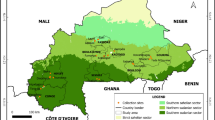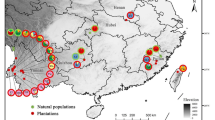Abstract
Natural populations of wild rice, Oryza rufipogon Griff., are now threatened with the disturbance of their natural habitats by various human activities. To obtain basic information on genetic erosion or loss of genetic diversity in wild rice, we investigated how environmental changes of habitat affected the genetic structure of its natural population at a study site in the central plain of Thailand. During 10 years from 1985 to 1994, the wild-rice population at this site was seriously destroyed and fragmented. Using two sets of seed sample collected in 1985 and 1994 from the same population, allozyme variability at 17 loci of 11 enzymes were examined. Isozyme genotypes of mother plants of seed samples were estimated by the segregation in each progeny, and we calculated genetic parameters for the population. Gene diversity severely decreased in the 1994 sample compared with the 1985 sample. It is supposed that declining and fragmentation of the wild rice population, which happened during the 10 years, caused loss of genetic variability and forced the habitually outbreeding plants to inbreed, accelerating a reduction in gene variability. Pgi1-1 allele which was common in Indica rice cultivars of this region was found in the wild rice plants growing at the side of rice fields. Probably, introgression has occurred between wild and cultivated rice plants, and consequently the intrinsic nature of wild rice was gradually blurred by cultivar genes. We must realize that the genetic erosion of wild rice is rapidly proceeding and that an action for their conservation in natural environment, so called in situ conservation, is urgently needed.
Similar content being viewed by others
References
Barbier, P., 1989a. Genetic variation and ecotypic differentiation in the wild rice species Oryza rufipogon. I. Population differentiation in life-history traits and isozymic loci. Jpn. J. Genet. 64: 259–271.
Barbier, P., 1989b. Genetic variation and ecotypic differentiation in the wild rice species Oryza rufipogon. II. Influence of the mating system and life-history trait on the genetic structure of populations. Jpn. J. Genet. 64: 273–285.
Brown, A. H. D. & R. W. Allard, 1970. Estimation of the mating system in open-pollinated maize populations using isozyme polymorphisms. Genetics 66: 133–145.
Charlesworth, D. & B. Charlesworth, 1987. Inbreeding depression and its evolutionary consequences. Ann. Rev. Ecol. Syst. 18: 237–268.
Chitrakon, S., 1994. Genetic erosion of rice in Thailand. Tropics 3: 223–225.
Frankham, R., 1995. Conservation genetics. Ann. Rev. Genet. 29: 305–327.
Glaszmann, J. C., 1988. Electrophoretic variation of isozymes in plumules of rice (Oryza sativa L.) — A key to the identification of 76 alleles at 24 loci. IRRI Res. Paper Ser. 134: 3–14.
Hancock, J. F., 1992. Plant Evolution and the Origin of Crop Species. Prentice Hall, Englewood Cliffs, NJ.
Hartl, D. L. & A. G. Clark, 1989. Principles of Population Genetics. Sinauer Associates, Sunderland.
Hughes, J. B., G. C. Daily & P. R. Ehrlich, 1997. Population diversity: its extent and extinction. Science 278: 689–692.
Ishikawa, R., H. Morishima, K. Mori & T. Kinoshita, 1989. Chromosomal analyis of isozyme loci and the allelic expression at cellular level in rice — Genetic studies of rice plants, XCVII. J. Fac. Agric. Hokkaido Univ. 64, Pt. 1: 85–98.
Leberg, P. L., 1992. Effects of population bottlenecks on genetic diversity as measured by allozyme electrophoresis. Evolution 46: 477–494.
Maxted, N., B. V. Ford-Lloyd & J. G. Hawkes, 1997. Complementary conservation strategies. In: Maxted, N., B. V. Ford-Lloyd & J. G. Hawkes (Eds.), Plant Genetic Conservation; The in situ Approach, Chapman & Hall, London, pp. 15–40.
Morishima, H., 1994. Observations at permanent study-site of wild rice in the suburb of Bangkok. Tropics 3: 227–233.
Morishima, H., Y. Shimamoto, Y. Sano & Y. I. Sato, 1984. Observations on wild and cultivated rices in Thailand for ecological genetic study: Report of study-tour in 1983. National Institute of Genetics, Mishima.
Morishima, H., Y. Shimamoto, Y. Sano & Y. I. Sato, 1987. Trip to Indonesia and Thailand for the ecological genetic study in rice. National Institute of Genetics, Mishima.
Morishima, H., Y. Shimamoto, T. Sato, H. Yamagishi & Y. I. Sato, 1991. Observations of wild and cultivated rices in Bhutan, Bangladesh and Thailand. National Institute of Genetics, Mishima.
Nei, M., 1973. Analysis of genetic diversity in subdivided populations. Proc. Natl. Acad. Sci. U.S. A. 70: 3321–3323.
Nei, M., 1978. Estimation of average heterozygosity and genetic distance from small number of individuals. Genetics 89: 583–590.
Nei, M., 1987. Molecular Evolutionary Genetics. Columbia Univ. Press, New York, NY.
Oka, H. I. & W. T. Chang, 1961. Hybrid swarms between wild and cultivated rice species, Oryza perennis and O. sativa. Evolution 15: 418–430.
Plucknett, D. L., N. J. H. Smith, J. T. Williams & N. M. Anishetty, 1987. Gene Banks and The World's Food. Princeton University Press, Princeton, NJ.
Prance, G. T., 1997. The conservation of botanical diversity. In:Maxted, N., B. V. Ford-Lloyd & J. G. Hawkes (Eds.), Plant Genetic Conservation; The in situ Approach, Chapman & Hall, London, pp. 3–14.
Rieseberg, L. H. & S. M. Swensen, 1996. Conservation genetics of endangered island plants. In: Avise, J. C. & J. L. Hamrick (Eds.), Conservation Genetics; Case History from Nature, Chapman & Hall, London, pp. 305–334.
Ritland, K. & S. Jain, 1981. A model for the estimation of outcrossing rate and gene frequencies using n independent loci. Heredity 47: 35–52.
Sano, Y., H. Morishima & H. I. Oka, 1980. Intermediate perennial– annual populations of Oryza perennis found in Thailand and their evolutionary significance. Bot. Mag. Tokyo 93: 291–305.
Sato, Y. I. (Ed.), 1994. Ecological–Genetic Studies on Wild and Cultivated Rice in Tropical Asia (4th survey). Tropics 3: 189–244.
Second, G. & P. Trouslot, 1980. Électrophor`se d'enzymes de riz (Oryza ap.) (in French). ORSTOM, Paris.
Vaughan, D. A. & T. T. Chang, 1992. In situ conservation of rice genetic resources. Econom. Bot. 46: 368–383.
Author information
Authors and Affiliations
Rights and permissions
About this article
Cite this article
Akimoto, M., Shimamoto, Y. & Morishima, H. The extinction of genetic resources of Asian wild rice, Oryza rufipogon Griff.: A case study in Thailand. Genetic Resources and Crop Evolution 46, 419–425 (1999). https://doi.org/10.1023/A:1008622405001
Issue Date:
DOI: https://doi.org/10.1023/A:1008622405001




